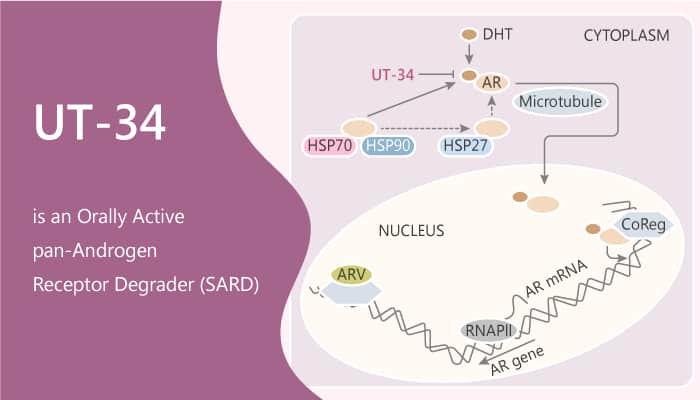Prost ate cancer drugs targeting the androgen receptor (AR) are mainly competitive ligand-binding domain (LBD) binding antagonists. A common mechanism of drug resistance can inactivate it. Specifically, AR is a nuclear receptor that is activated by binding to any androgen. In addition, radical prostatectomy combined with gonadotropin and androgen synthetase inhibitor, androgen receptor antagonist, has been the main method of PCA treatment. Besides, the current ar antagonists and clinical trials are both competitive antagonists, and their mechanisms are similar. Moreover, AR is a member of the steroid receptor family of ligand-activated transcription factors. It contains an N-terminal domain (NTD), a hormone recognition DNA binding domain (DBD) response element, a hinge region, and LBD containing AF-2. Furthermore, drugs targeting steroid receptors work mainly by binding to LBD. UT-34 is a potent, selective, and orally active second-generation pan-androgen receptor (AR) antagonist and degrader.
ate cancer drugs targeting the androgen receptor (AR) are mainly competitive ligand-binding domain (LBD) binding antagonists. A common mechanism of drug resistance can inactivate it. Specifically, AR is a nuclear receptor that is activated by binding to any androgen. In addition, radical prostatectomy combined with gonadotropin and androgen synthetase inhibitor, androgen receptor antagonist, has been the main method of PCA treatment. Besides, the current ar antagonists and clinical trials are both competitive antagonists, and their mechanisms are similar. Moreover, AR is a member of the steroid receptor family of ligand-activated transcription factors. It contains an N-terminal domain (NTD), a hormone recognition DNA binding domain (DBD) response element, a hinge region, and LBD containing AF-2. Furthermore, drugs targeting steroid receptors work mainly by binding to LBD. UT-34 is a potent, selective, and orally active second-generation pan-androgen receptor (AR) antagonist and degrader.
UT-34 is a selective and orally active second-generation pan-androgen receptor degrader (SARD).
How does UT-34 protect against prostate cancer cells via AR? Let’s discuss it in detail. First of all, UT-34 inhibits AR with IC50s of 211.7 nM, 262.4 nM, and 215.7 nM for wild-type, F876L, and W741L AR, respectively. Meanwhile, UT-34 binds to the ligand-binding domain (LBD) and function-1 (AF-1) domains and requires the ubiquitin-proteasome pathway to degrade the AR.
In the second place, UT-34 treatment inhibits the expression of PSA and FKBP5 and the growth of LNCaP cells starting from 100 nM to 10 μM. Treatment of ZR-75-1 cells maintained in serum-containing growth medium with UT-34 results in the downregulation of AR protein levels. But it is not with estrogen receptor (ER) or progesterone receptor (PR) levels. Furthermore, in MDA-MB-453 breast cancer cells that express AR and glucocorticoid receptor (GR), UT-34 induces the downregulation of AR, but not GR. Nonetheless, UT-34 is an effective degrader of both AR and AR-V7.
Last but not the least, UT-34 at 20 and 40 mg/kg reduces the seminal vesicle weight by 10%-20% and 50%-60 %, respectively. Additionally, UT-34 inhibits androgen-dependent tissues and the growth of Enzalutamide-resistant castration-resistant prostate cancer (CRPC) xenografts. Importantly, UT-34 also induces tumor regression in intact immunocompromised rats. All in all, UT-34 is a potent, selective, and orally active second-generation pan-androgen receptor (AR) degrader.
References:
Ponnusamy S, et al. Clin Cancer Res. 2019 Nov 15;25(22):6764-6780.